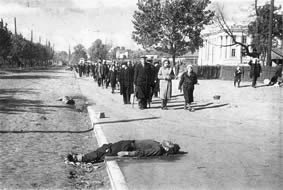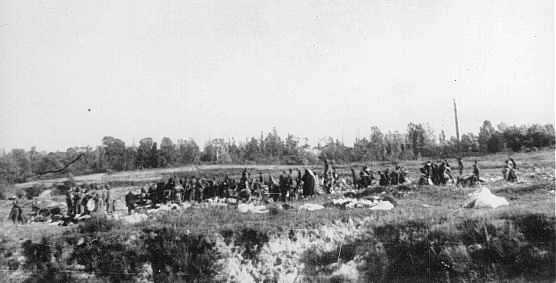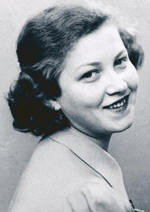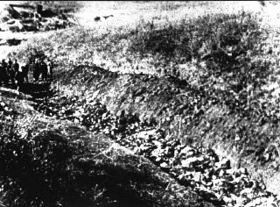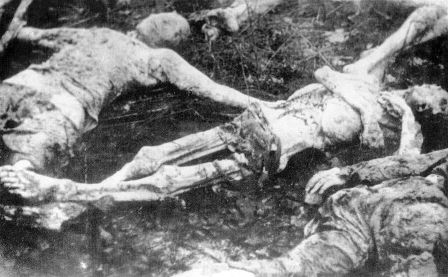Holocaust Education & Archive Research Team |
|
Einsatzgrϋppen
Einsatz Group A Einsatz Group B Einsatz Group C Einsatz Group D Babi Yar Articles Einsatz Leaders Einsatzgruppen Operational Situational Reports [ OSR's #8 - #195 ] | |||||
Babi Yar Witness and Survivor accounts of the Mass Murder in Kiev
Fritz Hoefer - Eyewitness to Mass Murder
Testimony at the Einsatzgruppen war crimes trial:
One day I was ordered to drive my truck out of town. I had a Ukrainian with me. It was about 10 a.m. On our way, we passed Jews marching in columns in the same direction, we were going. They were carrying their belongings. There were whole families. The farther we drove away from the town, the more people we saw in the columns. There were piles of clothes in a wide open field. My job was to fetch them.
I stopped the engine nearby, and the Ukrainians standing around started loading the car with this stuff. From where I was, I saw other Ukrainians meeting the Jews who arrived, men, women and children, and directing them to the place where, one after another, they were supposed to remove their belongings, coats, shoes, outer garments and even their underwear.
They were supposed to put all their belongings together in a pile. Everything happened very quickly, the Ukrainians hurried those who hesitated by kicking and pushing them. I think it took less than a minute from the moment a person took off his coat before he was standing completely naked.
No distinction was made between men, women and children. The Jews who were arriving could have turned back when they saw those who had come earlier taking off their clothes. Even today I cannot understand why they didn’t run.
Naked Jews were led to a ravine about 150 metres long, 30 metres wide and 15 metres deep. The Jews went down into the ravine through two or three narrow paths. When they got closer to the edge of the ravine, members of the Schutzpolizei (Germans) grabbed them and made them lie down over the corpses of the Jews who had already been shot.
It took no time. The corpses were carefully laid down in rows. As soon as a Jew lay down, a Schutzpolizist came along with a sub-machine gun and shot him in the back of the head.The Jews who descended into the ravine were so frightened by this terrible scene that they completely lost their will. You could even see some of them lying down in the row on their own and waiting for the shot to come.
Only two members of the Schutzpolizei did the shooting. One of them was working at one of the ravine, the other started at the other end. I saw them standing on the bodies and shooting one person after another.
Walking over the corpses toward a new victim who had already laid down, the machine gunner shot him on the spot. It was an extermination machine that made no distinction between men, women and children.Children were kept with their mothers and shot with them. I did not watch for long. When I approached the edge, I was so frightened of what I that I could not look at it for a long time.
I saw dead bodies at the bottom laid across in three rows, each of which was approximately 60 metres long. I could not see how many layers were there. It was beyond my comprehension to see bodies twitching in convulsions and covered with blood, so I could not make sense of the details.Apart from the two machine gunners, there were two other members of the Schutzpolizei standing near each passage into the ravine.
They made each victim lie down on the corpses, so that the machine gunner could shoot while he walked by. When victims descended into the ravine and saw this terrible scene at the last moment, they let out a cry of terror. But they were grabbed by the waiting Schutzpolizei right away and hurled down onto the others.
Those who followed them could not see the terrible scene because it was obstructed by the edge of the ravine. While some people were getting undressed and most of the others were waiting their turn, there was a lot of noise. The Ukrainians paid no attention to the noise and just kept forcing people through the passages into the ravine.
You could not see the ravine from the site where people were taking off their clothes, because it was situated about 150 metres away from the first pile of clothes. Besides, a strong wind was blowing and it was very cold. You couldn’t hear the shooting in the ravine.
So I concluded that the Jews had no idea what was actually happening. Even today I wonder why the Jews did nothing to challenge what was going on. Masses of people were coming from town and they did not seem to suspect anything.
They thought they were just being relocated.
Testimony of Fritzi Schiffer Rumors about Babi Yar
Question: Did you hear about Babi Yar?
But my husband had a brother - my husband was from Bessarabia - came to our town. And his brother lived in Kiev because when Bessarabia became Romanian he run to the Soviets.
You know, the young people run wherever they want. So my husband never knew this brother because he was born when his brother was probably seventeen, eighteen and run away from home. So then he caught up with his brother, the year the Russians were in our town he caught up with his brother.
There's a long story, not for here, because it is very interesting, but I don't think you need it. He caught up with....it's a Jewish story, but...he caught up with his brother. His brother was in Kiev, and when Kiev, before Kiev was occupied, he got to Kharkov. And we came to Kharkov, running away from the Kholchoz. They gave us...we didn't run, they gave us the possibility to go. '
We didn't have money to buy train tickets. I don't know how we got - probably it was a possibility. And when we came to Kharkov, Kharkov was about to be occupied. So they didn't let men out, they let only women, so I went with his brother's wife, with three children, on a train over the Urals.
Fritzi: Yes. They were already in Tashkent. They came out and told us that they took the Jews in Kiev that were left over and they took them to Babi Yar, that is outside a ravine - they knew it, we didn't - and they killed all the Jews there in this ravine and they were crying and they were telling that they had friends
Dina Pronicheva I Survived the Mass Murder – Babi Yar
Dina Pronicheva testifying after the War :
After the end of the Second World War Dina Pronicheva told how she escaped from the mass murder at the Babi Yar ravine, during September 1941, to the Soviet writer Anatoli Kuznetsov. Kuznetsov published her story in Russia in 1966, and her moving story is recounted here.
All around and beneath her she could hear strange submerged sounds, groaning, choking and sobbing: many of the people were not dead yet. The whole mass of bodies kept moving slightly as they settled down and were pressed tighter by the movements of the ones who were still living.
Some soldiers came out on to the ledge and flashed their torches down on the bodies, firing bullets from their revolvers into any which appeared to be still living. But someone not far from Dina went on groaning as loud as before.
Then she heard people walking near her, actually on the bodies. They were Germans who had climbed down and were bending over and taking things from the dead and occasionally firing those which showed signs of life. Among them was the policeman who had examined her papers and taken her bag, she recognised him by his voice.
One SS-man caught his foot against Dina and her appearance aroused his suspicions. He shone his torch on her, picked her up and struck her with his fist. But she hung limp and gave no sign of life. He kicked her in the breast with his heavy boot and trod on her right hand so that the bones cracked, but he didn’t use his gun and went off, picking his way across the corpses.
A few minutes later she heard a voice calling from above: “Demidenko! Come on start shovelling.” There was a clatter of spades and then heavy thuds as the earth and sand landed on the bodies, coming closer and closer until it started falling on Dina herself.
Her whole body was buried under the sand but she did not move until it began to cover her mouth. She was lying face upwards, breathed in some sand and started to choke, and then, scarcely realising what she was doing, she started to struggle in a state of uncontrollable panic, quite prepared now to be shot rather than be buried alive.
With her left hand, the good one, she started scraping the sand off herself, scarcely daring to breathe lest she should start coughing: she used what strength she had left to hold the cough back. She began to feel a little easier. Finally she got herself out from under the earth.
The Ukrainian policemen up above were apparently tired after a hard day’s work, too lazy to shovel the earth in properly, and once they had scattered a little in they dropped their shovels and went away. Dina’s eyes were full of sand, it was pitch dark and there was the heavy smell of flesh from the mass of fresh corpses.
Dina could just make out the nearest side of the sandpit and started slowly and carefully making her way across to it: then she stood up and started making little foot-holds in it with her left hand. In that way, pressed close to the side of the pit, she made steps and so raised herself an inch at a time, likely at any moment to fall back into the pit.
There was a little bush at the top which she managed to get hold of. With a last desperate effort she pulled herself up and as she scrambled over the ledge, she heard a whisper which nearly made her jump back. “Don’t be scared, lady! I’m alive too.”
It was a small boy in vest and pants who had crawled out as she had done. He was trembling and shivering all over. “Quiet!” she hissed at him. “Crawl along behind me.” And they crawled away silently, without a sound.
Dina Pronicheva survived the horrors of Barbi Yar, the young boy who had escaped from the ravine with her, called out to her, as they sought to leave the area, he warned her that danger was near. Motyn, the young boy’s name, called out to her, “Don’t move, lady, there’s Germans here!”
The Germans killed him on the spot, but not understanding what he said, she made good her escape. Over 33,000 Jews were murdered in the Babi Yar, one of the worst single massacres in the history of mankind.
Sources:
The Holocaust Chronicle Publications International LTD Die Schoah von Babi Yar, Hartung-Gorre, Constance 1991 Berenbaum, Michael. Witness to the Holocaust. New York: HarperCollins. 1997 The Holocaust, by Sir Martin Gilbert, published by Collins, London, 1986 Yad Vashem Archives United States NARA
Copyright: 2008 Chris Webb H.E.A.R.T
|

